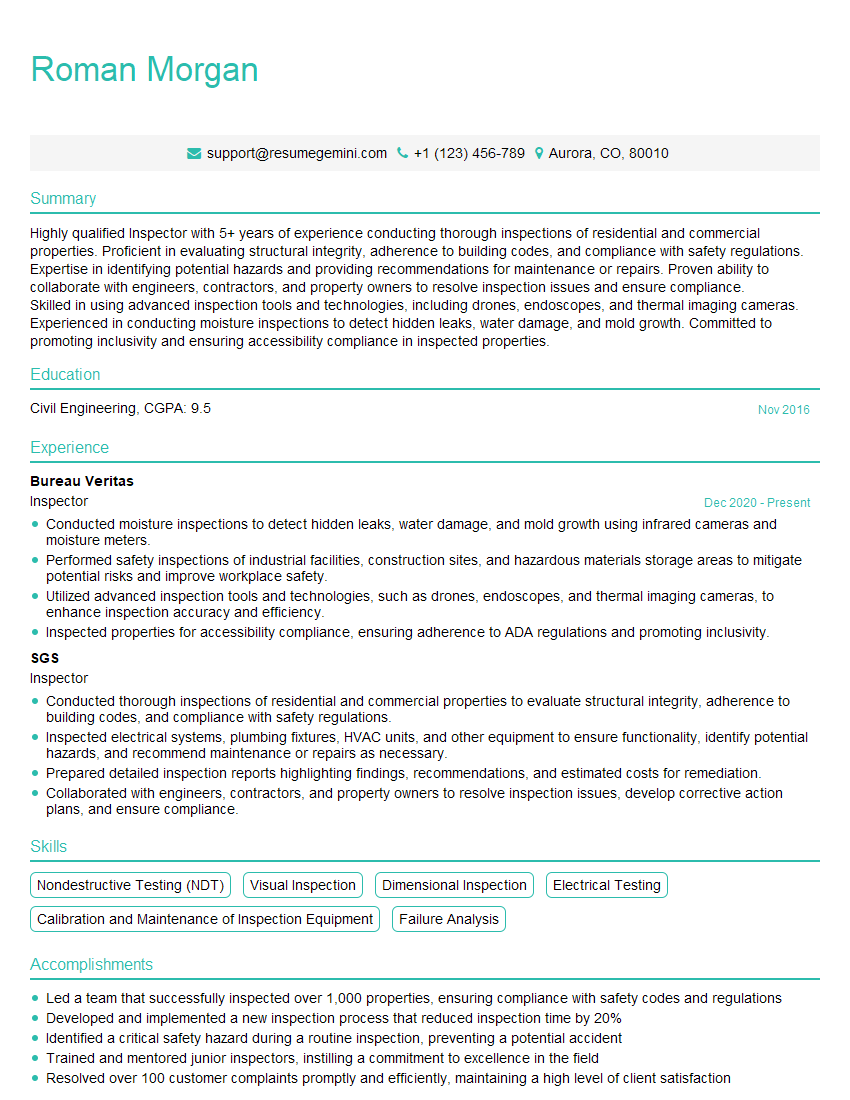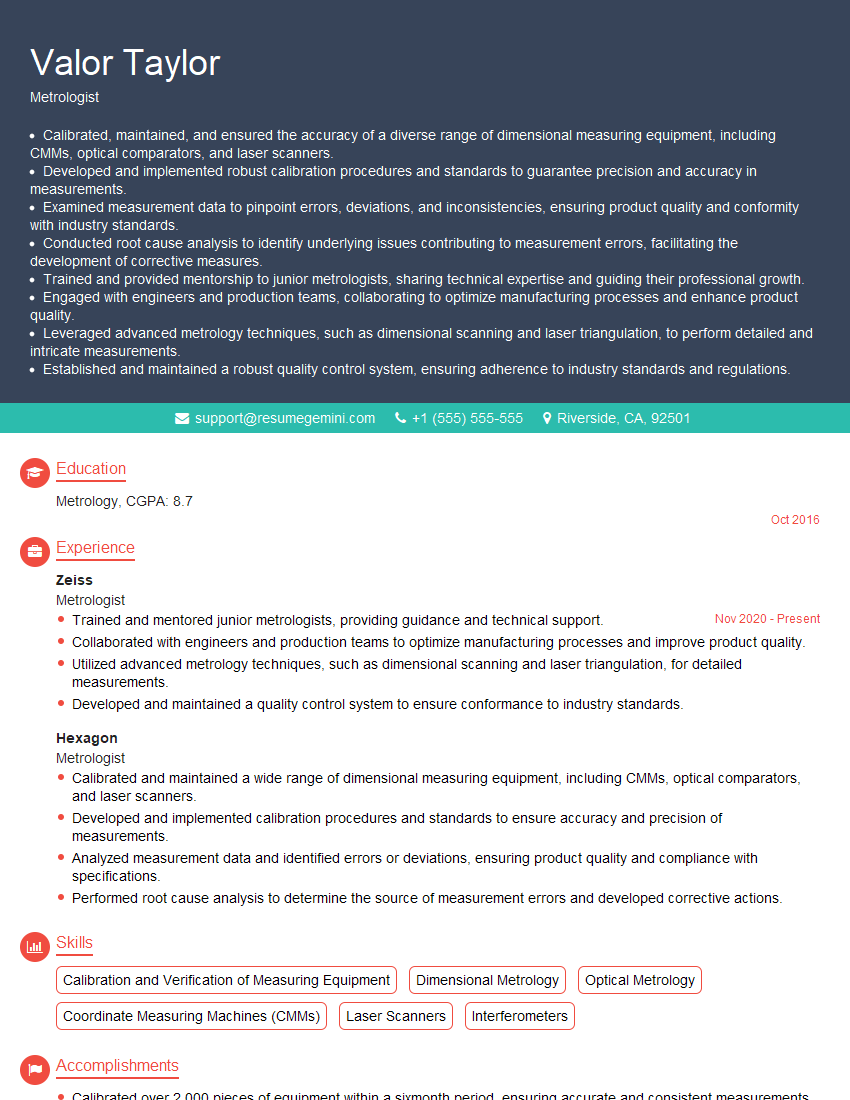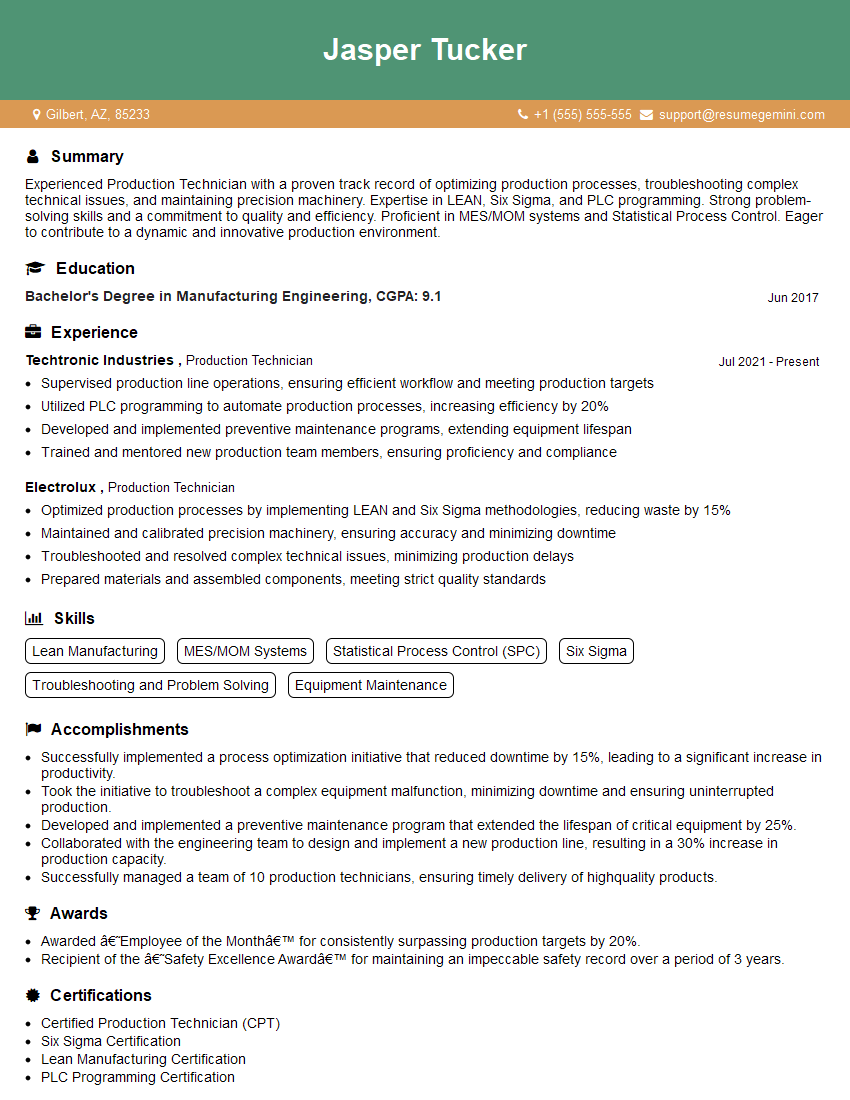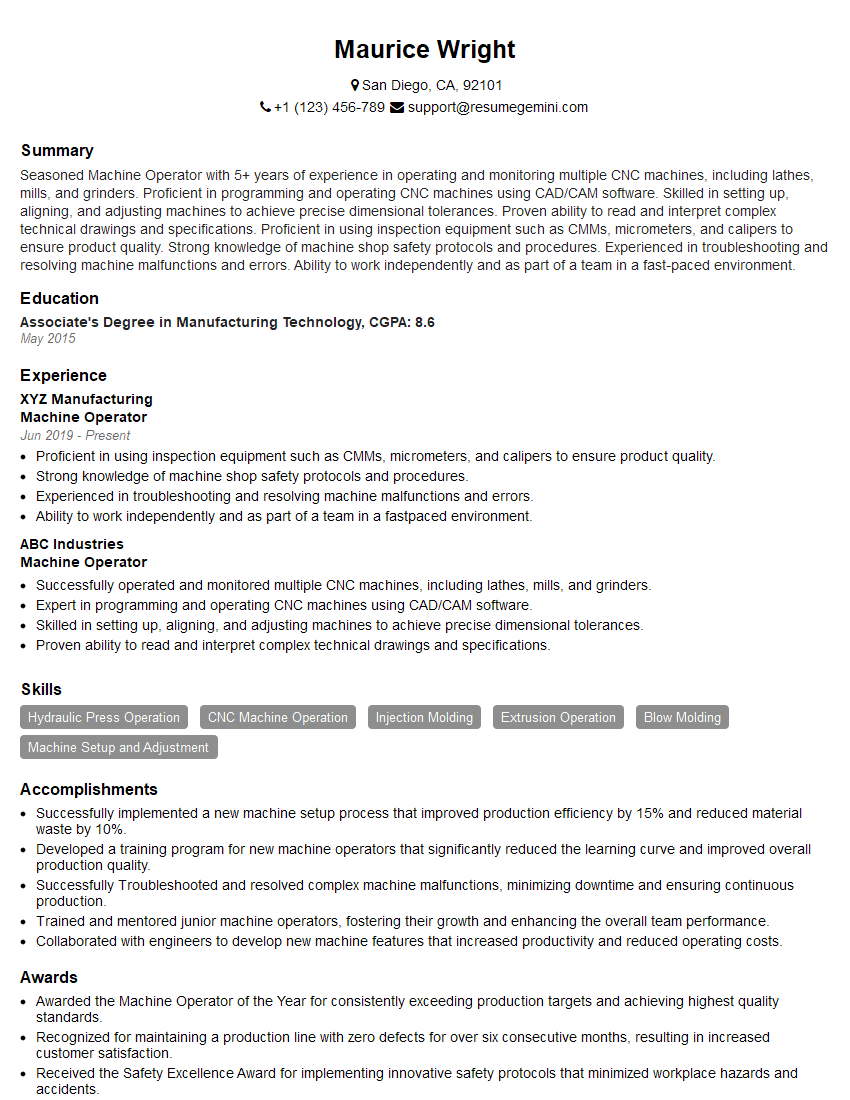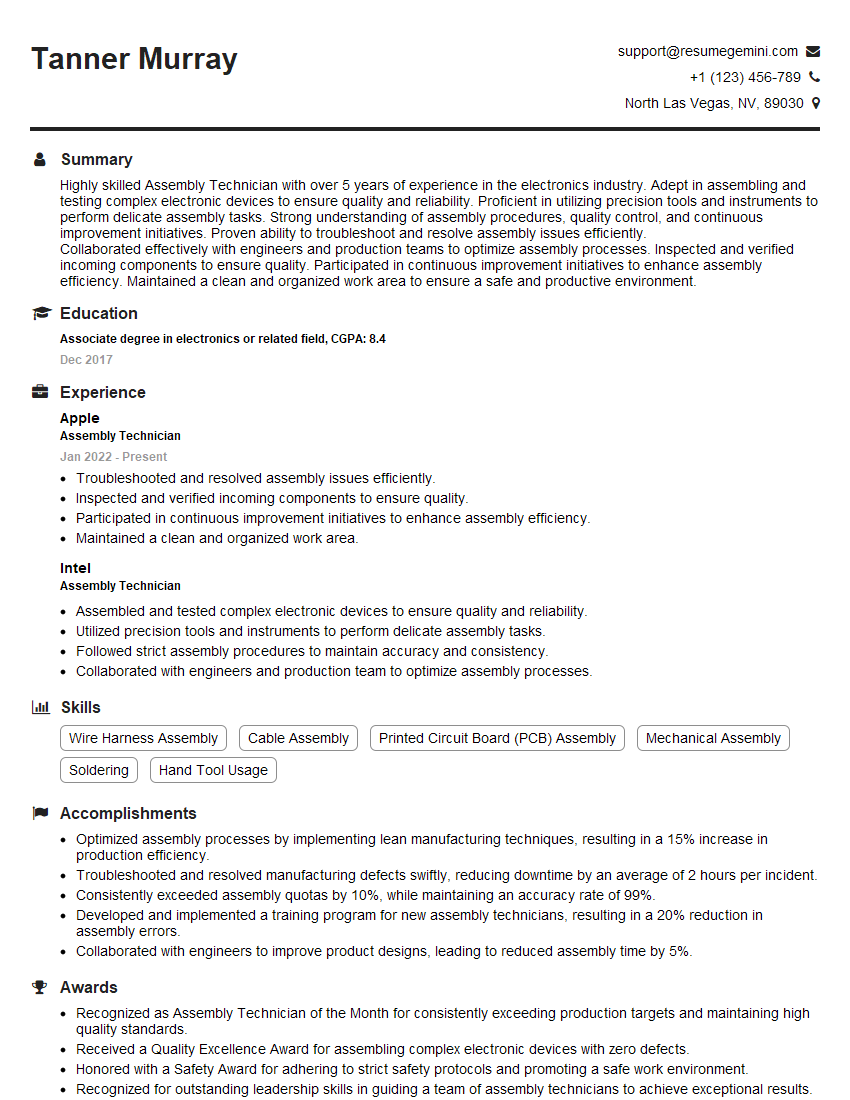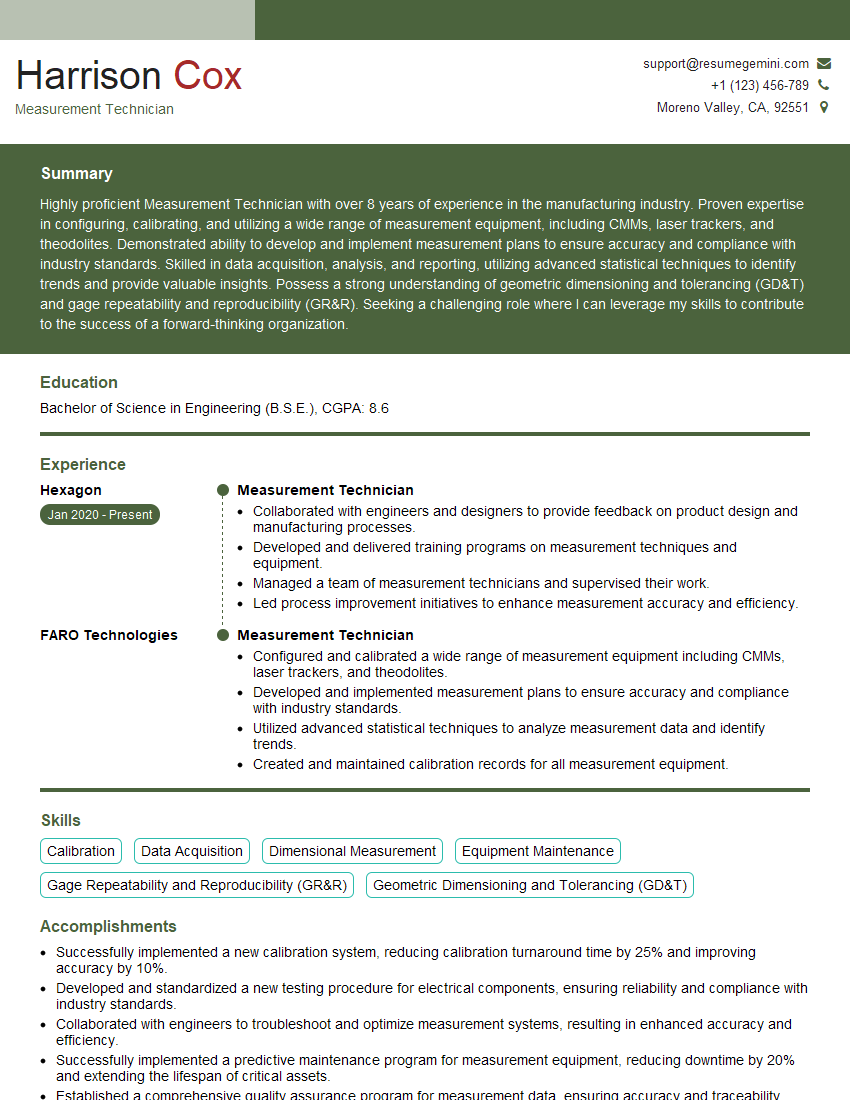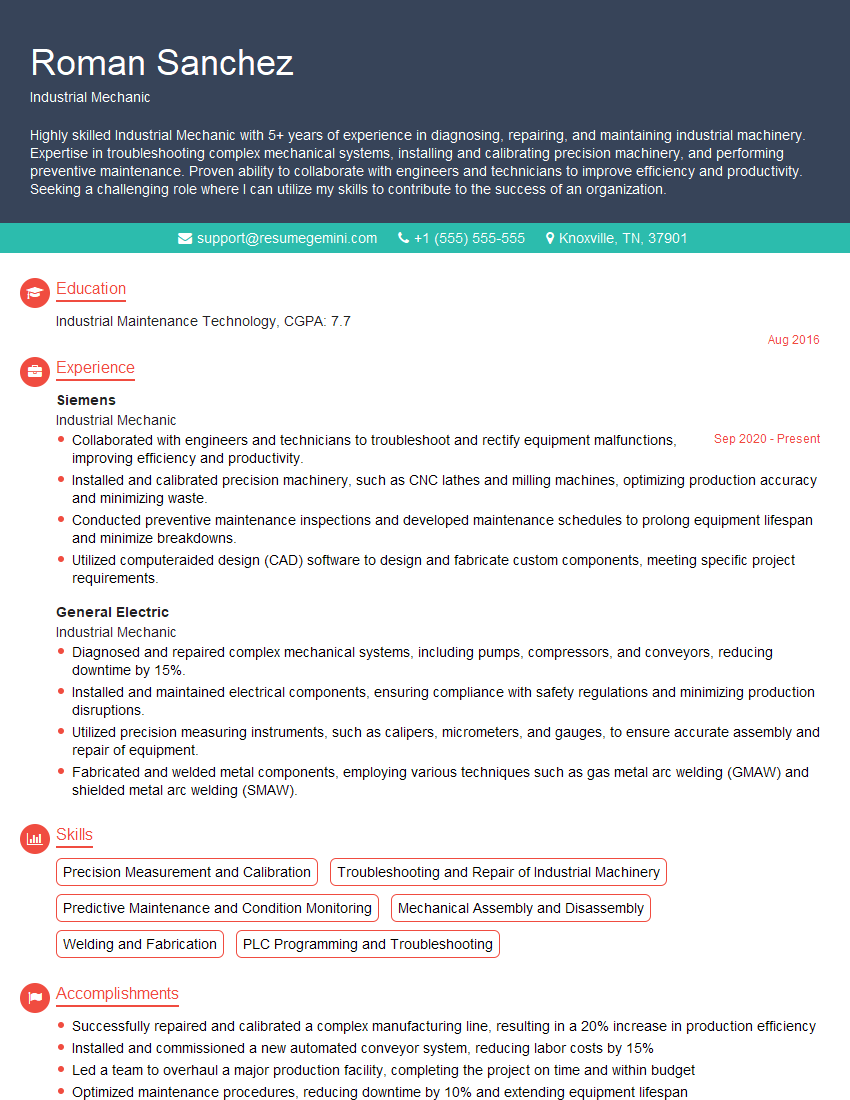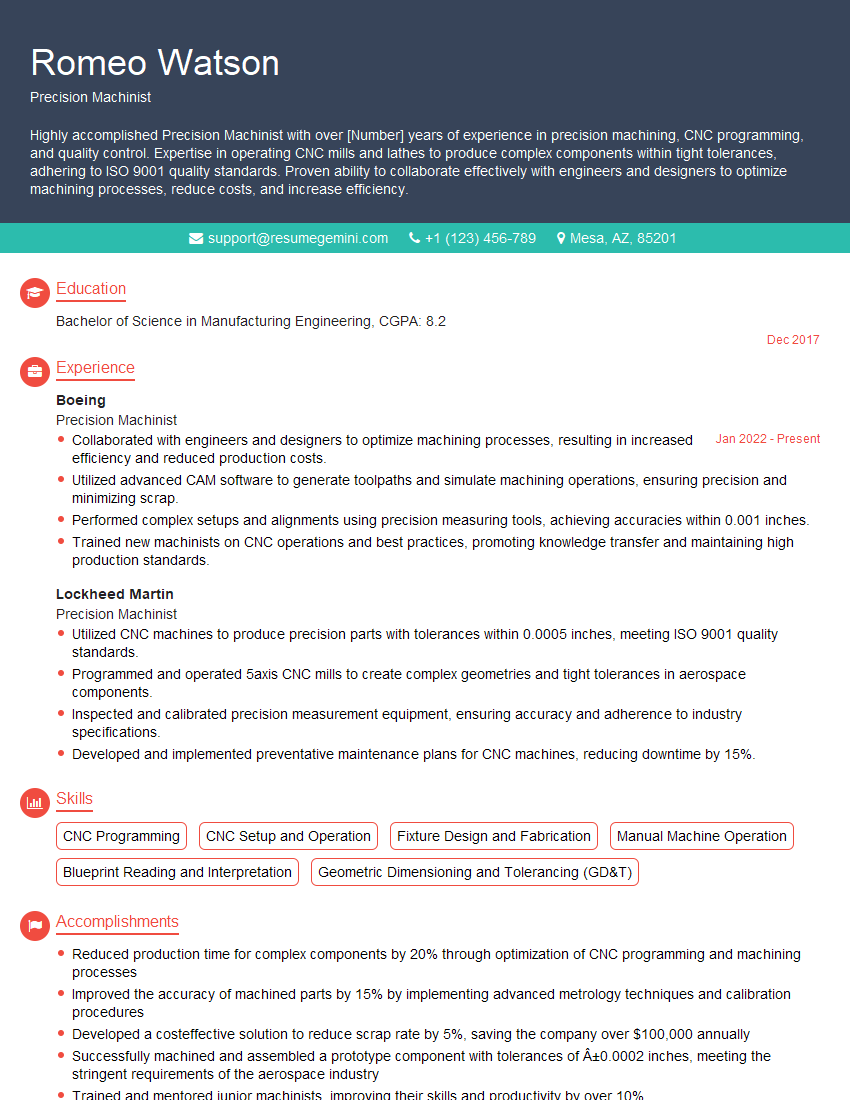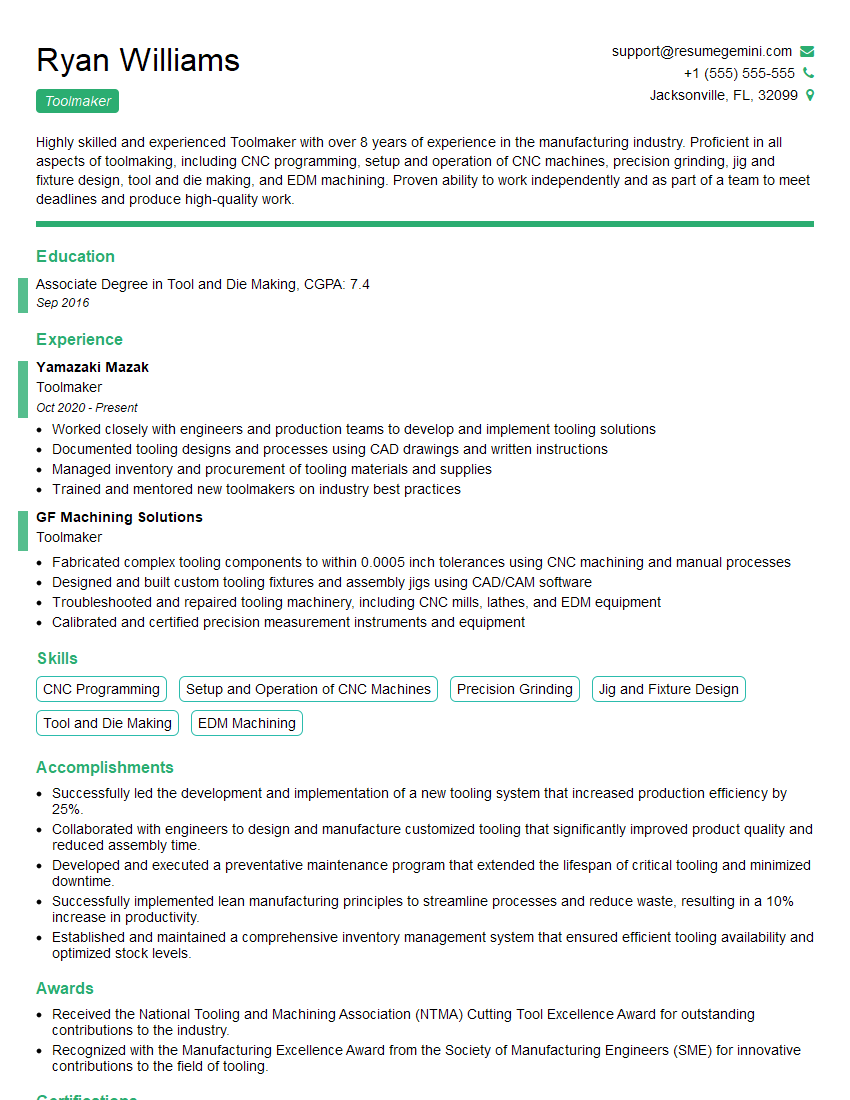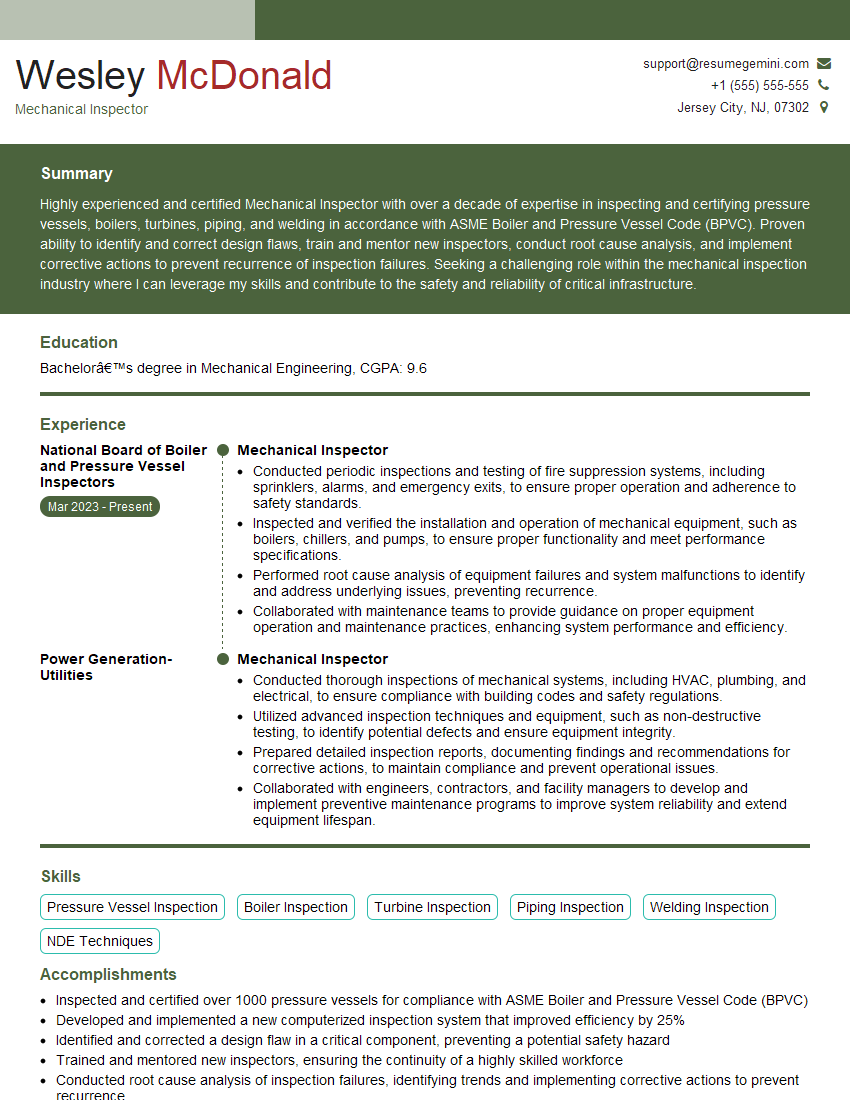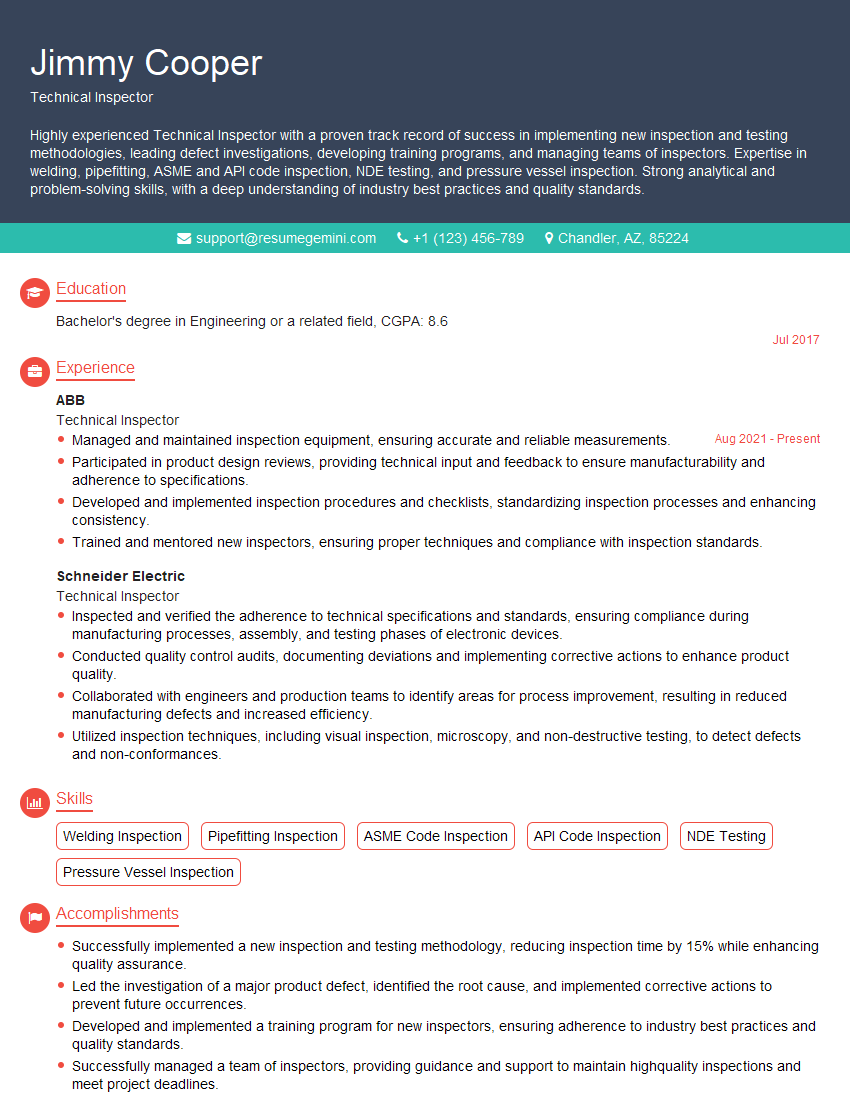Interviews are opportunities to demonstrate your expertise, and this guide is here to help you shine. Explore the essential Calipers and Micrometers Usage interview questions that employers frequently ask, paired with strategies for crafting responses that set you apart from the competition.
Questions Asked in Calipers and Micrometers Usage Interview
Q 1. What are the differences between vernier calipers and micrometers?
Vernier calipers and micrometers are both precision measuring instruments used to determine the dimensions of objects, but they differ in their design, accuracy, and ease of use. Vernier calipers use a sliding vernier scale to measure to a fraction of a millimeter or inch, offering relatively quick measurements. Micrometers, on the other hand, employ a precise screw mechanism for extremely fine measurements, typically to a thousandth of an inch or a hundredth of a millimeter. Think of it like this: vernier calipers are like a finely detailed ruler, while micrometers are like a super-precise, finely threaded screw.
- Accuracy: Micrometers are generally more accurate than vernier calipers.
- Range: Vernier calipers usually measure larger ranges than micrometers.
- Ease of use: Vernier calipers are often considered easier to learn and use, especially for quick measurements.
- Resolution: Micrometers provide significantly higher resolution than vernier calipers.
Q 2. Explain the principle of operation of a vernier caliper.
The vernier caliper operates on the principle of creating a secondary scale (the vernier scale) that slides alongside the main scale. The main scale is a standard ruler, marked in millimeters (or inches). The vernier scale has markings slightly smaller than those on the main scale (e.g., 9 divisions on the vernier scale equal 10 divisions on the main scale). When the jaws of the caliper are closed on an object, the main scale shows a rough measurement. The vernier scale indicates the fraction of the smallest division on the main scale. By finding the vernier marking that exactly aligns with a main scale marking, we determine the precise measurement.
Example: If the main scale shows 25mm and the 5th marking on the vernier scale aligns with a main scale marking, the measurement is 25.5mm, as each vernier division represents 0.1mm.
Q 3. How do you read a micrometer accurately?
Accurately reading a micrometer requires understanding its three scales: the sleeve (main scale), the thimble (rotating scale), and sometimes a ratchet. The sleeve shows measurements in millimeters and half-millimeters. The thimble rotates to measure the finer increments. The measurement is the sum of the sleeve reading and the thimble reading.
- Sleeve Reading: Note the millimeter markings on the sleeve visible before the thimble.
- Thimble Reading: Identify the line on the thimble that aligns with the line on the sleeve. Each line on the thimble represents a small fraction (usually 0.01mm or 0.001 inch).
- Ratchet (if present): Always use the ratchet to avoid applying too much pressure, which can lead to inaccurate readings.
Example: If the sleeve shows 5mm and the thimble shows 25, the measurement is 5.25mm. If using an inch micrometer, understanding the different graduations (e.g., 0.025 inches per thimble rotation) is crucial.
Q 4. What are the common sources of error when using calipers and micrometers?
Common sources of error when using calipers and micrometers include:
- Parallax Error: This occurs when the line of sight is not perpendicular to the scale, leading to inaccurate reading. Always view the scales directly from above.
- Zero Error: If the jaws don’t close perfectly at zero, a correction needs to be applied to all readings. Always check for zero error before taking any measurements.
- Incorrect pressure: Applying too much pressure when measuring can deform the object or the instrument itself, leading to inaccurate readings. Use the ratchet gently and consistently.
- Temperature variations: Significant temperature changes can affect the accuracy of the instrument due to thermal expansion.
- Wear and tear: Over time, the instrument can wear, impacting its accuracy. Regular calibration is essential.
- Improper handling: Dropping or mishandling can damage the instruments.
Q 5. How do you calibrate calipers and micrometers?
Calibrating calipers and micrometers typically involves comparing their measurements against a known standard, such as gauge blocks or a certified master instrument. The process differs slightly depending on the instrument and calibration standards.
- Gauge blocks: Gauge blocks are precisely manufactured blocks of known dimensions. By measuring the gauge blocks with the instrument and comparing the reading to the known dimension, any deviation reveals the calibration error.
- Calibration labs: Professional calibration services use sophisticated equipment to verify the accuracy and issue a calibration certificate.
- Adjusting zero error: Some instruments allow adjustment for zero error using calibration screws (usually done by a technician).
Regular calibration ensures the instruments provide accurate measurements, crucial for many quality control and manufacturing processes.
Q 6. What is the least count of a typical vernier caliper?
The least count of a typical vernier caliper is 0.02 mm or 0.001 inches. This means it can measure to the nearest 0.02 millimeters or 0.001 inches. However, the actual precision may be slightly less due to limitations in readability and potential for errors.
Q 7. What is the least count of a typical micrometer?
The least count of a typical micrometer is 0.01 mm or 0.0001 inches. Some micrometers even have a least count of 0.001 mm or 0.00001 inches, demonstrating significantly higher precision compared to vernier calipers. Again, the accuracy is influenced by factors like user skill, instrument condition, and environmental factors.
Q 8. How do you measure the inside diameter of a cylinder using calipers?
Measuring the inside diameter of a cylinder with calipers involves using the caliper’s inside jaws. These jaws are specifically designed to measure internal dimensions. Think of them as a reverse version of the outside jaws, perfect for snugly fitting inside a cylindrical space.
- Step 1: Gently insert the inside jaws of the caliper into the cylinder until they make firm contact with the opposite walls.
- Step 2: Carefully close the jaws until they feel snug against the cylinder’s inner surface. Avoid applying excessive force, which could damage the instrument or the cylinder.
- Step 3: Lock the caliper’s sliding jaw to maintain the measurement.
- Step 4: Read the measurement from the caliper’s scale. Take care to correctly interpret the main scale and vernier scale (if present), to achieve accurate readings.
For example, imagine you’re measuring a small metal pipe. Carefully insert the inside jaws, ensuring contact with both inner walls. The reading you get on the caliper will be the inside diameter of the pipe.
Q 9. How do you measure the depth of a hole using calipers?
Calipers aren’t ideally suited for measuring the depth of a hole, especially deep ones. Their design focuses on measuring distances between surfaces, rather than depths in a confined space. Depth micrometers or dedicated depth gauges are more appropriate for precise depth measurements. However, for shallow holes, you can use the caliper’s depth probe (if equipped).
- Step 1 (if using a depth probe): Extend the depth probe carefully into the hole until the probe’s tip touches the bottom.
- Step 2: Lock the sliding jaw and carefully remove the caliper from the hole.
- Step 3: Read the measurement from the caliper’s scale, ensuring that you’re looking at the depth measurement scale, not the outside/inside jaw scale.
It is important to note that inaccuracies can arise with this method due to the probe’s potential to bend or tip inside the hole. This is why dedicated depth measurement tools are preferred for higher accuracy.
Q 10. How do you measure the outside diameter of a shaft using a micrometer?
Measuring the outside diameter of a shaft with a micrometer is straightforward and offers high precision. Micrometers are known for their ability to measure extremely small differences in dimension.
- Step 1: Open the micrometer’s anvil and spindle enough to comfortably accommodate the shaft.
- Step 2: Gently place the shaft between the anvil and the spindle.
- Step 3: Slowly close the spindle using the thimble until the shaft is firmly held, but not compressed. You should feel a slight resistance. Over-tightening can damage both the shaft and the micrometer.
- Step 4: Read the measurement from the micrometer’s scale. This typically involves reading the main scale and the thimble scale, which together provide a highly precise reading, often down to thousandths of an inch or micrometers.
Imagine measuring a precision-machined steel shaft for a motor. The accuracy of a micrometer is critical here to ensure the shaft fits perfectly.
Q 11. How do you measure the thickness of a sheet of metal using a micrometer?
Measuring the thickness of a sheet of metal with a micrometer is similar to measuring the diameter of a shaft, but it requires attention to ensure the sheet is flat and not bent or warped, as this would affect the accuracy of the reading.
- Step 1: Ensure the sheet of metal is clean and flat. A warped or uneven surface will yield an inaccurate measurement.
- Step 2: Open the micrometer’s anvil and spindle.
- Step 3: Place the sheet of metal between the anvil and spindle.
- Step 4: Carefully close the spindle using the thimble until the sheet is snug but not under pressure.
- Step 5: Read the measurement from the micrometer’s scale, paying close attention to both the main scale and the thimble scale.
Consider quality control in a sheet metal fabrication shop. Using a micrometer ensures consistent sheet thickness, crucial for structural integrity and meeting specifications.
Q 12. Explain the difference between an inside and outside micrometer.
The key difference lies in their jaw configurations. An outside micrometer has a fixed anvil and a movable spindle, used to measure the outside diameter of objects. Think of it like a very precise and adjustable pair of calipers.
An inside micrometer features a different mechanism. Instead of measuring the outer diameter, it measures the internal diameter of objects, such as the inside of a pipe or a cylindrical bore. It usually has rods or extensions that extend into the space being measured.
In essence, one measures external dimensions, while the other tackles internal ones.
Q 13. How do you clean and maintain calipers and micrometers?
Regular cleaning and maintenance are essential for ensuring the accuracy and longevity of calipers and micrometers. These precision instruments are susceptible to damage from dirt, debris, and corrosion.
- Cleaning: Use a soft, lint-free cloth to wipe down the surfaces of the instruments after each use. For stubborn grime, a gentle cleaning solution designed for precision instruments can be used. Avoid harsh chemicals or abrasive materials.
- Lubrication: Apply a small amount of high-quality instrument lubricant to the moving parts of the instrument, such as the sliding jaw on calipers or the thimble on micrometers. This ensures smooth operation and prevents wear.
- Storage: Store calipers and micrometers in their designated cases when not in use to protect them from damage and keep them clean.
- Calibration: Regularly check the calibration of the instruments using precision gauge blocks or by sending them to a professional calibration laboratory. This ensures continued accuracy.
Think of it like caring for a fine watch. Regular maintenance keeps the instrument precise and reliable.
Q 14. What safety precautions should be taken when using calipers and micrometers?
Safety when using calipers and micrometers centers around preventing injury and instrument damage.
- Careful Handling: Always handle calipers and micrometers with care. Avoid dropping them or subjecting them to impacts, which can affect their accuracy.
- Proper Technique: Use the correct measuring technique. Over-tightening can damage both the instrument and the measured object.
- Work Area: Maintain a clean and organized workspace to prevent accidents caused by dropped tools or debris.
- Eye Protection: Wear safety glasses to protect your eyes from flying debris in case of accidental slippage of the object being measured.
- Avoid Cross-Contamination: Clean the instruments after each use to prevent cross-contamination of materials, particularly in industries such as pharmaceuticals or food processing.
Following these simple precautions ensures safe and efficient use of these valuable measurement tools.
Q 15. Describe the process of zeroing a vernier caliper.
Zeroing a vernier caliper is crucial for accurate measurements. It ensures that the caliper reads zero when the jaws are completely closed. This process eliminates any systematic error caused by jaw misalignment or wear. Here’s how you do it:
- Close the jaws: Gently but firmly close the jaws of the caliper.
- Locate the zero adjustment screw: Most vernier calipers have a small screw, usually located near the main scale, that’s used for zeroing.
- Adjust the zero: Use a small screwdriver to carefully turn the zero adjustment screw. Observe the main and vernier scales to align the zero marks. This means the zero mark on the vernier scale should precisely line up with the zero mark on the main scale.
- Verify the zero: Gently open and close the jaws several times to check that the reading remains at zero. If not, repeat the adjustment until accurate zeroing is achieved.
Think of it like calibrating a scale before weighing something – you need a clean starting point for accurate results. Failing to zero the caliper will result in consistently inaccurate measurements, potentially leading to costly errors in manufacturing or other precision tasks.
Career Expert Tips:
- Ace those interviews! Prepare effectively by reviewing the Top 50 Most Common Interview Questions on ResumeGemini.
- Navigate your job search with confidence! Explore a wide range of Career Tips on ResumeGemini. Learn about common challenges and recommendations to overcome them.
- Craft the perfect resume! Master the Art of Resume Writing with ResumeGemini’s guide. Showcase your unique qualifications and achievements effectively.
- Don’t miss out on holiday savings! Build your dream resume with ResumeGemini’s ATS optimized templates.
Q 16. What are the different types of micrometers?
Micrometers come in various types, each designed for specific applications. The most common types include:
- Outside Micrometer (Micrometer Caliper): This is the most common type, used to measure the external diameter of objects such as shafts, rods, and cylinders. It has a fixed anvil and a movable spindle.
- Inside Micrometer: This type measures the internal diameter of objects like holes and bores. It features two measuring rods extending from the frame to contact the inner walls of the object.
- Depth Micrometer: Used to measure the depth of holes, slots, or recesses. It has a long spindle that extends into the object’s depth.
- Leaf Micrometer: These are less common now, possessing a simpler design with a leaf spring mechanism. They have limited resolution.
- Digital Micrometers: These feature a digital display providing direct readout of the measurement, improving readability and reducing operator error. They often incorporate data logging capabilities.
The choice of micrometer depends entirely on the geometry of the part being measured. Selecting an inappropriate type will yield inaccurate or impossible measurements.
Q 17. How do you handle worn or damaged calipers and micrometers?
Worn or damaged calipers and micrometers should never be used for precise measurements. They can lead to significant errors and potentially costly mistakes. Here’s how to handle them:
- Inspection: Regularly inspect your tools for signs of wear, damage (bent jaws, worn anvils), or loose components.
- Calibration: Worn tools need recalibration to determine the extent of the error. Regular calibration is crucial for maintaining accuracy. A gauge block set is essential for this process.
- Repair or Replacement: Minor damage like cleaning or tightening loose screws might be manageable. However, significant wear or damage necessitates repair by a qualified technician or replacement with a new, properly calibrated tool. A severely damaged tool is unreliable, rendering any measurements taken with it suspect.
- Proper Storage: Store your tools in a clean, dry environment to prevent corrosion and accidental damage. Use protective cases to avoid impact damage.
Imagine using a worn-out ruler – you wouldn’t trust its measurements! Similarly, using damaged precision measuring tools compromises your work’s accuracy and reliability.
Q 18. What is the significance of proper calibration in precision measurement?
Proper calibration in precision measurement is paramount because it ensures the accuracy and reliability of the measuring instrument. A calibrated tool provides traceable measurements to a known standard, making the results trustworthy and comparable to other measurements worldwide. Uncalibrated instruments introduce systematic errors which are consistent and difficult to detect without calibration, leading to unreliable results. These errors can propagate through the entire manufacturing process, resulting in rejected parts, wasted materials, and potential safety issues. Calibration verifies the instrument’s conformity to national or international standards. The frequency of calibration depends on the tool’s usage and the precision required. For critical applications, frequent calibration is essential to maintain the required accuracy and precision.
Q 19. Explain the concept of precision and accuracy in measurement.
In measurement, precision and accuracy are distinct but related concepts.
- Accuracy refers to how close a measurement is to the true value. Think of it as hitting the bullseye on a target.
- Precision refers to the reproducibility of a measurement. It indicates how close multiple measurements are to each other. This is like consistently hitting the same spot on the target, even if that spot isn’t the bullseye.
A measurement can be precise but not accurate (repeatedly hitting the same spot off-center) or accurate but not precise (randomly hitting near the bullseye).
Ideal measurements are both accurate and precise; this means consistent results that are also close to the actual value. In manufacturing, a high level of both is necessary to guarantee product quality and conformity to specifications.
Q 20. What is the difference between resolution and accuracy?
Resolution and accuracy are often confused but have distinct meanings in measurement.
- Resolution refers to the smallest increment a measuring instrument can display. A micrometer with a resolution of 0.01 mm can display measurements to the nearest 0.01 mm. It’s the fineness of the scale.
- Accuracy, as discussed previously, refers to how close a measurement is to the true value. It represents the closeness of the measured value to the actual value.
High resolution doesn’t automatically guarantee high accuracy. A high-resolution instrument might still produce inaccurate readings if it’s not properly calibrated or if there are systematic errors. For example, a micrometer might have a high resolution (0.001 mm) but inaccurate readings if its measuring surfaces are worn.
Q 21. How do you choose the appropriate caliper or micrometer for a specific measurement task?
Choosing the right caliper or micrometer hinges on several factors:
- Size of the object: The instrument’s measuring range must encompass the object’s dimensions. A small caliper won’t measure a large diameter.
- Shape of the object: Consider the object’s geometry. An outside micrometer is for external diameters, inside for internal, and depth for depths.
- Required precision: The instrument’s resolution should meet the measurement’s precision requirements. A micrometer offers higher resolution than a caliper.
- Material of the object: The instrument’s jaws should be suitable for the material to avoid damage or scratching.
- Application: Some applications might require digital readouts for ease of use and data recording.
For instance, measuring a small screw’s diameter would require a micrometer for high precision, while measuring the thickness of a wooden plank might suffice with a caliper. Always choose the instrument that best balances the required precision with the object’s size and shape.
Q 22. How do you identify and interpret different markings on calipers and micrometers?
Understanding the markings on calipers and micrometers is fundamental to accurate measurement. Both tools use scales to indicate length. Calipers typically have an inch scale and a metric scale (millimeters) marked with main graduations and subdivisions. The main graduations represent larger units (e.g., inches or centimeters), while subdivisions show smaller increments (e.g., 1/16th of an inch or 0.1mm). Micrometers, known for their higher precision, use a rotating thimble with finer graduations to measure extremely small distances. The main scale on the micrometer sleeve displays millimeters, while the thimble displays hundredths of a millimeter (0.01mm). For example, a reading on the micrometer’s sleeve of 5 mm and 25 on the thimble indicates a measurement of 5.25 mm.
Vernier scales are often present on calipers, adding extra precision. These are a series of smaller markings that allow readings between the main graduations. Learning to accurately interpret these markings requires practice and attention to detail, as does understanding the difference between inside, outside, and depth measurements. Each measurement type uses a specific jaw on the caliper.
- Inch Scale: Usually displays inches and fractions (e.g., 1/2, 1/4, 1/8, 1/16).
- Metric Scale: Displays millimeters and sometimes centimeters.
- Vernier Scale: Increases the precision of the main scale reading.
- Micrometer Thimble: Shows hundredths of a millimeter (0.01mm).
Q 23. Describe a time you had to troubleshoot a measurement issue.
During a quality control check on a batch of precision-machined parts, we noticed a significant discrepancy in the measurements of a specific dimension using our standard calipers. Several parts consistently measured slightly smaller than the specified tolerance. Initially, we suspected a faulty machining process. We recalibrated the calipers using a gauge block of known precision, but the issue persisted. We then realized the calipers were slightly out of alignment, causing the error.
Troubleshooting involved the following steps:
- Recheck Calibration: We meticulously recalibrated the calipers and confirmed the accuracy using the gauge block.
- Inspect the Calipers: We examined the calipers carefully for damage (e.g., bent jaws, loose components) that could compromise measurements.
- Check the Measurement Technique: We checked if the measurement process was being performed correctly, verifying proper jaw selection and the absence of force applied during measurement.
- Verify the Gauges and other tools: We carefully inspected all the other instruments used to ensure accurate results.
- Alternative Measurement Method: To further verify measurements, we used a micrometer for extra precision to measure a few critical sample parts.
By systematically investigating potential causes, we identified the misalignment of the calipers as the source of the discrepancy. This highlighted the importance of regular maintenance and calibration to ensure accurate measurements.
Q 24. How do you record and document measurement data?
Accurate record-keeping is crucial for traceability and accountability in any measurement process. I use a standardized data sheet or a digital spreadsheet to record all measurements. Each entry includes:
- Part Identification: A unique identifier for the part being measured.
- Date and Time: Provides context for the measurements.
- Measurement Type: Specifies the dimension (length, width, depth, diameter, etc.).
- Measured Value: The actual measurement obtained.
- Units: Clearly states the units used (e.g., mm, inches).
- Instrument Used: Identifies the specific caliper or micrometer used.
- Operator Name: For accountability and traceability.
- Environmental conditions: (where applicable) for advanced precision applications.
If using digital calipers or micrometers, the data is often automatically logged. This data is then transferred to a database or spreadsheet, enhancing data organization and analysis. Maintaining clear and consistent documentation ensures the integrity of the measurement data and aids in future analysis and comparisons.
Q 25. How do you handle discrepancies in measurements?
Discrepancies in measurements necessitate careful investigation. The first step involves repeating the measurement multiple times using the same instrument and technique. If the discrepancies persist, several factors should be considered:
- Instrument Calibration: Verify that the instrument is properly calibrated. If not, recalibrate or replace it.
- Measurement Technique: Ensure the correct measurement technique is being applied consistently. Properly align the jaws and avoid excessive pressure.
- Instrument Condition: Inspect the instrument for any damage or wear that could affect accuracy.
- Environmental Factors: Consider environmental conditions such as temperature and humidity, which might slightly impact measurements.
- Part Variation: In some cases, the variation might be inherent to the part itself.
If the discrepancy remains after these checks, using a second, independent measuring instrument can provide a confirmation. Documentation of all steps and findings is crucial. In cases where differences are still unresolved, you might need to involve a metrology expert to assess the situation further.
Q 26. Explain the importance of using the correct measuring units.
Using the correct measuring units is paramount for clarity, accuracy, and avoiding costly errors. Mixing units or using incorrect units can lead to misinterpretations, flawed calculations, and potential safety hazards. Imagine a situation where you’re building an airplane engine and a crucial dimension is mistakenly entered using inches instead of millimeters. This could have disastrous consequences.
Always clearly indicate the units used for every measurement. In engineering, scientific, and manufacturing contexts, adhering to the established standards (metric or imperial) is crucial for consistent communication and compatibility with international standards. Consistency also minimizes the risk of errors in design, manufacturing, and assembly processes.
Q 27. Describe the limitations of using calipers and micrometers.
While calipers and micrometers are invaluable measuring tools, they do have limitations. Their accuracy is dependent on several factors, including:
- User Skill: Inaccurate reading or improper technique can introduce significant errors.
- Instrument Calibration: Regular calibration is essential to maintain accuracy. Uncalibrated instruments can lead to inaccurate and unreliable measurements.
- Instrument Wear: Over time, the jaws and other components of the instruments may wear, affecting the accuracy of measurements.
- Measurement Range: Calipers and micrometers have limited measurement ranges. Very small or very large dimensions may be difficult or impossible to measure accurately.
- Part Geometry: Complex shapes or surfaces may be difficult to measure accurately.
Moreover, they may not be suitable for all applications. For instance, measurements involving very fragile components might necessitate alternative methods to avoid damage to the part itself.
Q 28. What are some advanced techniques or applications for using calipers and micrometers?
Beyond basic linear measurements, calipers and micrometers can be used for a variety of advanced applications:
- Depth Measurement: Using the depth probe on calipers to measure the depth of holes or recesses.
- Step Measurement: Using calipers to determine differences in height or depth between two surfaces.
- Radius and Diameter Measurement: Using specialized calipers to measure radii or diameters of curved surfaces.
- Thread Measurement: Specialized calipers exist for measuring thread pitch and diameter.
- Statistical Process Control (SPC): Collecting multiple measurements over time to monitor process variation and control quality.
- Coordinate Measuring Machines (CMMs): Integrating micrometer-like precision within larger systems for highly precise 3D measurements.
Advanced techniques include using digital calipers and micrometers, which can store and transmit measurements electronically, enhancing data management and reducing manual errors. Understanding these advanced techniques enables efficient and highly precise dimensional analysis, especially critical in manufacturing and engineering contexts.
Key Topics to Learn for Calipers and Micrometers Usage Interview
- Understanding Basic Principles: Learn the fundamental differences between calipers and micrometers, their respective applications, and the units of measurement used (inches, millimeters).
- Reading Calipers: Master reading both Vernier and Digital calipers accurately. Practice identifying the main scale, vernier scale (for Vernier calipers), and digital display. Understand the concept of least count and its implications.
- Reading Micrometers: Become proficient in reading both inch and metric micrometers. Understand the thimble, barrel, and sleeve, and how to calculate measurements precisely. Practice identifying zero error and how to compensate for it.
- Practical Applications: Explore real-world scenarios where calipers and micrometers are used. This includes measuring various shapes and sizes of objects, determining tolerances, and performing basic calculations based on measurements.
- Precision and Accuracy: Understand the importance of precision and accuracy in measurement. Learn about potential sources of error and how to minimize them. Practice identifying and correcting measurement errors.
- Calibration and Maintenance: Learn about the importance of regular calibration and maintenance of calipers and micrometers to ensure accurate readings. Understand the procedures for cleaning and proper storage.
- Advanced Techniques: Explore more advanced techniques such as depth measurement, inside/outside measurements, and step measurements using calipers and micrometers.
- Problem-Solving: Practice solving measurement problems that require the use of both calipers and micrometers. Focus on interpreting measurement results and drawing relevant conclusions.
Next Steps
Mastering the use of calipers and micrometers demonstrates crucial precision and attention to detail—highly valued skills in many technical fields. This expertise significantly boosts your career prospects, opening doors to exciting opportunities and higher earning potential. To maximize your chances of landing your dream job, creating a strong, ATS-friendly resume is essential. ResumeGemini is a trusted resource that can help you build a professional resume that highlights your skills and experience effectively. Examples of resumes tailored to showcase Calipers and Micrometers Usage expertise are available through ResumeGemini to help guide you. Invest in your future—build a winning resume today!
Explore more articles
Users Rating of Our Blogs
Share Your Experience
We value your feedback! Please rate our content and share your thoughts (optional).
What Readers Say About Our Blog
good
